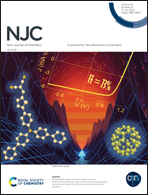Engineering diformyl diaryldipyrromethane into a molecular keypad lock†
Abstract
Sensor materials that undergo a change in fluorescence behaviour upon binding with cations and anions are one of the most widely used analytical tools and they can be used for various molecular switches and logic gates. Here, we have designed a photolabile chemosensor for both anions and cations by using a simple acyclic molecule, diformyl diaryldipyrromethane, and integrated it as a molecular keypad lock system. The molecular keypad lock works with respect to three inputs, with UV irradiation as input 1, where diformyl diaryldipyrromethane undergoes a photoenolization process to generate the dienol with intense green fluorescence. Further, the addition of anions such as F− or CN− (input 2) promotes deprotonation to yield the corresponding mono and dianions followed by emission changes from green to red and yellow, respectively. The generated dianions can effectively complex with Zn2+ ions to result in “turn on” fluorescence at 444 nm (yellow to blue) and thus Zn2+ ions are used as input 3. The output signal (λem = 444 nm) depends not only on the proper combination but also on the correct sequence of input signals, i.e., UV, F− (or CN−) and finally Zn2+ ions, mimicking a keypad.



 Please wait while we load your content...
Please wait while we load your content...